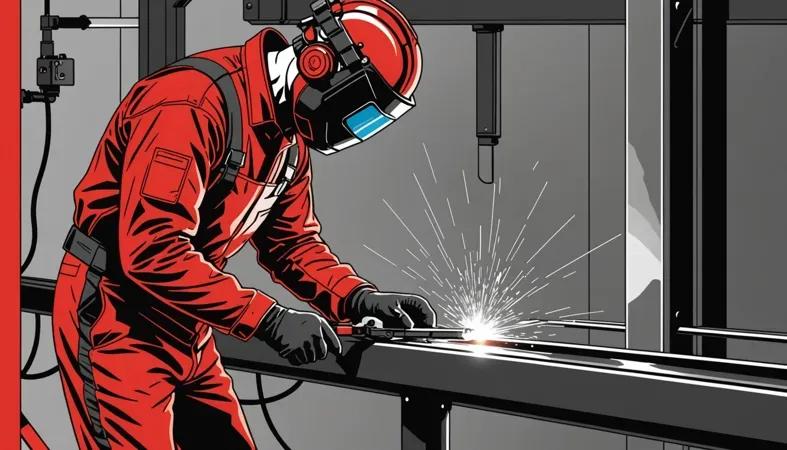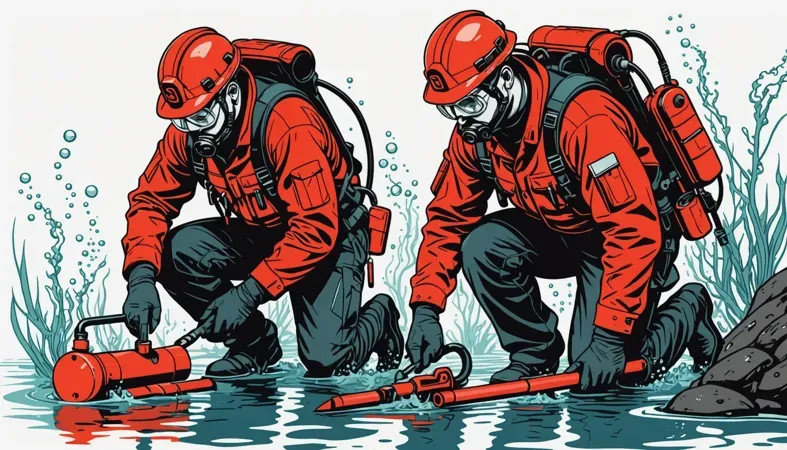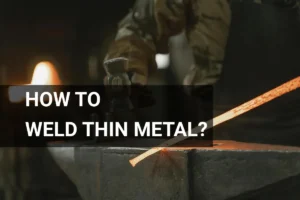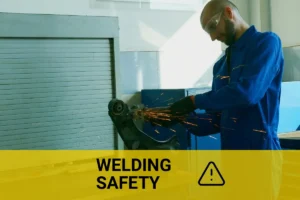How to Weld Upside Down? Tips, Techniques, and Key Considerations
Published on: June 1, 2025 | Last modified: March 4, 2025
By: Joe Carter
Welding upside down refers to the process of welding while positioned underneath the joint you’re working on. It’s a tricky method that requires specific techniques and practice.
People often ask us how to weld upside down. It’s crucial to learn this skill because many projects may require working in tough positions. During my training, I found that mastering this technique opened up new opportunities and made me more confident in my welding abilities.
In this guide, we’ll cover types of welding upside down, prerequisites before you start, steps for welding upside down, precautions, factors affecting welding upside down, common issues, aftercare and inspection tips, benefits you can expect, typical applications, and some other options to consider. We’ll also touch on how to arc weld upside down, along with insights into can you mig weld upside down and how to stick weld upside down.
Contents
- How to Weld Upside Down?
- What is Welding Upside Down?
- Types Of Welding Upside Down
- Prerequisites Before You Start
- Steps for Welding Upside Down
- Precautions
- Types Of Welding Techniques for Upside Down
- Best Posture for Welding Upside Down
- Factors Affecting Welding Upside Down
- Common Issues
- Aftercare, Inspection, and Advanced Tips for Welding Upside Down
- Top Benefits You Can Expect
- Typical Applications
- Other Options You Can Consider
- Frequently Asked Questions (FAQs)
- Conclusion
- Additional Reading
How to Weld Upside Down?
Welding upside down means executing welds while facing the ground. To weld upside down, use a lower voltage, maintain a steady arc, and favor a short arc length. It’s tricky but common in pipe and structural projects.
What is Welding Upside Down?
Welding upside down, or overhead welding, involves welding a joint while positioned beneath the workpiece. This technique requires specialized skills and different settings from standard welding methods. For arc welding upside down, a shorter arc length—about 1/8 inch (3.2 Mm)—is typical. Overhead welding can reduce productivity by 20-30%, so you need to know what you’re doing.
How do you weld upside down? Transitioning to this position takes practice. I remember trying it for the first time and struggling to maintain a steady hand. With time and experience, my technique improved greatly.
I used this technique during a major project at my friend’s workshop. We were fixing an old car and had to string weld the frame while lying on our backs. When I stick welded upside down, I realized the importance of adjusting my welding settings for the best results. It’s crucial for preventing unwanted spatter and ensuring strong, clean welds!
Types Of Welding Upside Down
What are the types of welding when you’re upside down?
-
Stick Welding
Stick welding uses a rod coated in flux to create a weld. To weld upside down, maintain a steady hand and a proper angle. Keep the electrode at a 15-30 degree angle from vertical and use a shorter arc length to minimize spatter.
-
MIG Welding
MIG welding feeds a continuous wire to create a weld. Can you MIG weld upside down? Yes! Use a higher voltage for good penetration and adjust the feed speed to control puddle movement.
-
TIG Welding
TIG welding is precise, using a non-consumable tungsten electrode. Can you TIG weld upside down? Absolutely! Steady your torch hand and keep the angle shallow, around 15 degrees, to control the filler rod placement.
-
Flux-cored Arc Welding
Flux-cored welding is similar to MIG but uses tubular wire filled with flux. To weld upside down, set your machine for fast travel speeds and work at a slight incline for better control.
-
Multi-process Welding
This method combines several welding processes. Can you weld upside down? Yes! Flexibility is key, so adjust your parameters based on the specific welding process. Experiment with settings to find the right balance.
We have now covered the different types of welding techniques. Next, we will examine the essential prerequisites before you start.
Prerequisites Before You Start
What do you need to get started?
- Welding Machine: You need a welder, such as the Lincoln Electric K2185-1, that is GMAW (Gas Metal Arc Welding) or FCAW (Flux-cored Arc Welding) capable. It provides stable input and controls welding in overhead positions.
- Electrodes: Use electrodes like E7014 or E6013 with a 3.2 mm (1/8 in) diameter. These types maintain good arc stability when you’re working upside down.
- Welding Wire: Get flux-cored wire, such as Hobart 500559. You’ll want .030-inch (0.8 Mm) for excellent penetration in overhead positions.
- Work Clamp: Use a strong ground clamp, like the Miller Electric 300204, to ensure a secure connection for effective welding without interruptions.
- Welding Helmet: A premium auto-darkening helmet, like the Lincoln Electric VIKING 3350, is crucial for visibility and boasts a 1/1/1/1 optical clarity rating for welding upside down.
So far we covered the prerequisites needed to begin. Next, let’s look at the steps for welding in an upside-down position.
Steps for Welding Upside Down
Here are the steps to weld with your head upside down correctly.
-
Get Comfortable
First, position yourself correctly. Choose a stable surface to sit or kneel on. Ensure you aren’t straining your neck or back. Comfort while welding can improve precision and reduce fatigue.
I rushed this once. After a few minutes, my neck hurt, and my focus slipped. Being comfortable makes welding upside down much easier!
-
Set Your Welder Parameters
Adjust your welder for overhead conditions. For MIG, set wire feed speed between 9 to 15 inches per minute (229 to 381 Mm/min) and a voltage range of 20 to 26 volts. For stick welding, select lower amperage to avoid burn-through, usually between 90 to 130 amps. To ensure proper polarity settings, understanding what DCEP means in welding is crucial.
For TIG welding, use 100% argon gas at about 15-20 cfh (Cubic Feet Per Hour). Always adjust settings based on your material; thicker materials might need more amperage, while thin sheets require less.
-
Choose the Right Technique
Use a push technique for MIG welding upside down. This keeps your arc steady and reduces spatter. Stick welders should use a whip technique, pulling the rod slowly for an even bead.
A consistent arc length of about 1/4 inch (6 Mm) works well. It keeps everything clean and minimizes defects. Experiment a bit to find what feels right for you.
-
Focus on Bead Control
Maintain control of your weld bead when welding overhead. Start with a slower travel speed, especially if you’re new to upside-down welding. Watch for sagging; aim for a smooth, consistent finish. For effective tips on this technique, refer to the welding guidance available online. If puddles form, speed up slowly.
Master the skills required to weld in overhead positions.
-
Practice
Finally, practice makes perfect! Set aside time each week to work on upside-down welding techniques. You’ll get accustomed to the feel of the torch and the adjustments needed for stable, strong overhead joints. To enhance your skills, it’s beneficial to understand the submerged arc welding process.
Track your progress. If you struggle, breaking down each step will lead to improvement. It really helped me while I was learning!
So far we covered the methods for welding in an inverted position. Next, let’s look at the necessary safety precautions.

Precautions
Let’s review crucial safety measures for welding upside down.
- Wear a helmet: It protects your head and eyes from sparks. I recommend the Lincoln Electric 25593, which blocks 99% of UV light and reduces eye strain.
- Secure your workpiece: Keep it steady while welding to prevent shifts. Use clamps rated for at least 500 lbs (225 Kg) for safety.
- Check your surroundings: Hazards can be above or below you. Clear flammable materials at least 35 ft (10 M) from your work area.
- Use a welding blanket: It prevents unwanted sparks from starting fires. Having a 12 ft x 12 ft (3.66 M X 3.66 M) fire-retardant blanket nearby is wise.
Prioritizing safety means returning home safely after welding!
You should now have a good understanding of safety measures for welding. In the next part, we’ll discuss various welding techniques for upside-down applications.
Types Of Welding Techniques for Upside Down
Let’s explore the types of welding techniques for vertical applications. We’ll cover Ceiling Welding, Overhead MIG Welding, Underneath TIG Welding, Upward Flux-Cored Welding, and Inverted Stick Welding.
Using welding equipment allows for efficient thawing of frozen pipes, which requires a specific process to ensure safety and effectiveness. the steps to thaw pipes.
-
Ceiling Welding
Ceiling welding involves working on an overhead surface. It requires steady hands and skill. Use a small-diameter electrode (Such As 2.4 Mm or 1/10 Inch) to better control the puddle.
-
Overhead MIG Welding
For MIG welding upside down, keep the wire speed high. This helps prevent burns and ensures a clean weld. Tip: Use short-circuit transfer mode at about 20-22 volts for optimal results.
-
Underneath TIG Welding
TIG welding upside down can be challenging. Maintain an angle of about 15-20 degrees. I’ve found that using a smaller tungsten electrode (Around 1.0 Mm or 0.040 Inch) improves precision.
-
Upward Flux-cored Welding
For flux-cored welding, set a push angle of 10-20 degrees. This helps control the molten metal. A good rule of thumb is to use a wire diameter of 0.8 mm (0.030 Inch) for a solid bead.
-
Inverted Stick Welding
Stick welding upside down requires slower speeds and patience. Opt for a 3.2 mm (1/8 Inch) electrode for a stable arc. Use a weaving technique for a consistent bead.
Best Posture for Welding Upside Down
Your body positioning can impact the quality of your welds. Here’s how to stand or lay for optimum results:
- Comfortable Support: Use a padded mat or cushion if sitting.
- Stable Grip: Hold the torch with your dominant hand for control and comfort.
- Angle of Approach: Keep a slight slope (15-20 degrees) to maintain the arc length without disturbing the puddle.
Factors Affecting Welding Upside Down
What factors influence welding in an inverted position?
-
Welding Position
Your welding position is crucial. Overhead welding requires managing gravity more than any other position. If you’re MIG welding upside down, you’ll need to keep that molten pool from dripping, which may require a slower speed and a tighter arc.
-
Material Thickness
Thicker materials require more heat and a steady hand. When welding metal over 1/4 inch (6 Mm) thick upside down, adjust your heat settings to prevent inadequate penetration or burn-through.
-
Welding Speed
Speed can make or break your weld. Adjusting the speed while welding upside down helps control bead quality, especially with flux-cored welding, where you need to maintain a steady travel speed to avoid slag inclusions.
-
Electrode Type
The type of electrode plays a major role. For instance, you can stick weld upside down using E6010 or E7018 electrodes. E6010 provides deep penetration but has more spatter, while E7018 offers a smoother finish, which is crucial for aesthetics.
-
Heat Input
Managing heat input is essential for successful welding. Excess heat when welding upside down can lead to drooping beads and weak joints; aim for a heat input of around 1,000 to 2,000 J/in (39.37 To 78.74 J/mm) depending on the material.
A key aspect of achieving sound welds involves understanding the specifics of complete joint penetration welds.
Common Issues
Let’s look at the unique challenges you face when welding upside down.
-
Poor Penetration
Poor penetration can be an issue when welding upside down. Gravity pulls molten metal away, leading to angular welds or gaps. To fix this, increase your travel speed and adjust the wire feed rate for proper fusion.
Understanding different welding positions can help improve techniques and achieve better results in complex situations, including 3G welding processes.
-
Weld Contamination
Welding upside down often exposes you to more contamination. Dust or oil can drip onto your weld, causing discoloration or inclusions in the metal. Clean the area before welding and consider using a quality anti-spatter spray.
-
Excess Spatter
You may encounter more spatter when welding upside down due to gravity affecting the molten puddle. Check for small, dimpled spots where spatter lands. To reduce this, lower the voltage and increase the wire feed speed. Always keep a wire brush handy!
-
Uneven Bead Appearance
Upside down welding may result in uneven bead consistency. An inconsistent appearance indicates improper technique. Monitor your travel speed; a steady hand and consistent pace will yield better results.
-
Arc Stability Problems
Welding upside down can cause arc stability issues, leading to wild fluctuations. A clean workspace is crucial. Adjust your parameters or switch to a suitable electrode for better arc control.
Aftercare, Inspection, and Advanced Tips for Welding Upside Down
Here’s solid advice on caring for your welds, inspecting them, and advancing your skills.
Aftercare Tips
After welding upside down, clean the work area immediately. Use a wire brush or 80-grit flap disc to remove slag and debris. Check for residual heat—a quick touch can prevent burns!
Inspection
Inspecting welds made upside down requires close attention. Use a visual inspection to identify lack of penetration or slag inclusions—focus on the edges. A digital caliper is recommended to measure joint width precisely at 1.5 mm (0.06 In) for optimal weld strength.
Arc welding techniques offer insights into improving weld quality which can enhance success in challenging positions. Learn more about arc welding.
Expert Tips
I’d adjust your amperage settings to between 130 A and 150 A when working upside down to prevent overheating. Experiment with a weaving technique for better coverage and fusion—round motions work well. Lastly, practice with a higher wire feed speed, ideally 6 to 8 m/min (19.7 To 26.2 Ft/min), for consistent results.
Top Benefits You Can Expect
The main benefit of learning to weld upside down is versatility. I once used it for a tricky ceiling job, making my workspace much more adaptable.
Moreover, it enhances your skills, making you more valuable in the job market. You’ll improve your precision, boost your confidence, and reduce limitations in confined spaces.
Typical Applications
Welding upside down is useful for tricky projects. It has several applications, such as:
- Pipe Installation: Weld joints in tight spaces, commonly found in plumbing. It’s popular for its precision.
- Fabrication of Structural Beams: Connect beams in steel frameworks, where inverted welding improves joint access. Common at construction sites.
- Tank Fabrication: Weld the top seams of storage tanks. Upside-down techniques reduce spatter and ensure a clean finish. Frequently used in industrial settings.
- Automotive Repair: Repair undercarriage components on vehicles. This method reaches tough spots under raised cars. It’s a standard technique in body shops.

Master the art of welding upside down with proper techniques.
Other Options You Can Consider
There are ways to achieve similar results without mastering welding upside down. For instance, a stable platform or scaffolding can help you work at difficult angles. Through trial and error, I’ve discovered that products like the Miller Multimatic 215 allow you to switch easily between MIG and TIG, fantastic for various positions.
If you’re dealing with tougher joints or thick materials, consider using stick welding techniques. Tools like the Lincoln Electric K2278-1 can make a world of difference for welding uphill. It ensures better penetration and control, reducing the hassle when positioning yourself awkwardly. Mastering the technique of welding uphill effectively is crucial for achieving strong, reliable joints in challenging positions.
Frequently Asked Questions (FAQs)
Now let us look at some common questions I typically get asked about welding upside down.
What Welding Rod is Best for Welding Upside Down?
For welding upside down, a 6010 or 7018 welding rod is best. These rods provide a stable arc and good penetration, essential for this challenging position. The 6010 rod has a penetration of about 30% deeper compared to others, while 7018’s coating helps with arc stability under difficult angles.
How Hard is Overhead Welding?
Overhead welding is hard, mainly due to gravity affecting the weld puddle. It requires good technique to prevent sagging, which could cause defects or weak joints. Many welders find it takes around 10% longer to finish overhead than flat positions, increasing labor costs in the greenhouse industry.
Can You Mig Weld Upside Down?
Yes, you can MIG weld upside down, but it’s tricky. You’ll want to use short, controlled welds to avoid puddle issues. Changing the polarity and using a .035-inch (0.89 Mm) wire can also help counteract gravity’s pull.
Can You Tig Weld Upside Down?
Yes, you can TIG weld upside down. It requires strong hand control to maintain a steady arc. Using the right filler rod is crucial, as a rod diameter under 1/16 inch (1.59 Mm) helps keep the puddle manageable and reduces the risk of defects.
How to Stick Weld Upside Down?
Stick welding upside down is completely doable. Use a low amperage setting to lessen the flow of molten metal, which helps avoid excessive overhead puddling. Keeping the electrode at a 45-degree angle also allows for better control while creating a clean weld.
Conclusion
We covered the key aspects of welding upside down, including the types of welding, prerequisites, crucial steps, safety precautions, and techniques involved. We also talked about common issues, aftercare, inspection tips, the benefits, typical applications, and other options you can consider. These points are essential for mastering how to weld upside down efficiently.
In summary, welding upside down involves understanding the right techniques and equipment like a good helmet and proper posture. It’s about ensuring you set up well and keep safety in mind while working. Wishing you success in your welding projects as you tackle this challenging skill for tasks that require careful precision.
To deepen your understanding and skills in welding, feel free to explore more about welding.
Additional Reading
- American Welding Society. (2020). AWS A3.0: Standard Welding Terms and Definitions. Miami, FL: AWS.
- Howard B. Cary. (1997). Welding Manual. Upper Saddle River, NJ: Prentice Hall.
Joe Carter is a retired welding professional with over 40 years of hands-on experience in the industry, spanning ship repair, structural welding, and even underwater projects. Joe is a master of MIG, TIG, and Stick welding. Passionate about mentoring the next generation of welders, Joe now shares his decades of expertise and practical insights to help others build rewarding careers in welding.
American Welding Society, MIG Welding, Stick Welding, TIG Welding, Upside Down Welding, Welding, Welding Equipment, Welding Techniques, Welding Wire







